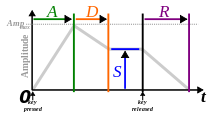Envelope (music)
In sound and music, an envelope describes how a sound changes over time. Envelopes may relate to elements such as amplitude (volume), a filter (frequencies), or pitch. For example, a piano key, when struck and held, creates a near-immediate initial sound, which gradually decreases in volume to zero. Envelope generators are common features of synthesizers, samplers, and other electronic musical instruments.
ADSR

The most common kind of envelope generator has four stages: attack, decay, sustain, and release (ADSR).[1]
- Attack is the time taken for initial run-up of level from nil to peak, beginning when the key is pressed.
- Decay is the time taken for the subsequent run down from the attack level to the designated sustain level.
- Sustain is the level during the main sequence of the sound's duration, until the key is released.
- Release is the time taken for the level to decay from the sustain level to zero after the key is released.[2]
While, attack, decay, and release refer to time, sustain refers to level.[1]
Other envelopes
Some electronic musical instruments can invert the ADSR envelope, reversing the behavior of the normal ADSR envelope. During the attack phase, the modulated sound parameter fades from the maximum amplitude to zero then, during the decay phase, rises to the value specified by the sustain parameter. After the key has been released the sound parameter rises from sustain amplitude back to maximum amplitude.
Some envelopes, such as that of the Korg MS-20, have an extra parameter, hold. This holds notes at the sustain level for a fixed length of time before decaying. The General Instruments AY-3-8912 sound chip includes only a hold time parameter only; the sustain level is not programmable.
Another common variation in the same vein is the AHDSR (attack, hold, decay, sustain, release) envelope, in which the "hold" parameter controls how long the envelope stays at full volume before entering the decay phase. Multiple attack, decay and release settings may be found on more sophisticated models.
Certain synthesizers also allow for a delay parameter before the attack. Modern synthesizers, such as the Prophet '08, have DADSR (delay, attack, decay, sustain, release) envelopes. The delay setting determines the length of silence between hitting a note and the attack. Some software synthesizers, such as Image-Line's 3xOSC (included with their DAW FL Studio) have DAHDSR (delay, attack, hold, decay, sustain, release) envelopes.
A common feature on many synthesizers is an AD envelope (attack and decay only). This can be used to control e.g. the pitch of one oscillator, which in turn may be synchronized with another oscillator by oscillator sync.
History
The Hammond Novachord in 1938 uses an early implementation of an ADSR envelope. A seven-position rotary knob set preset ADS parameter for all 72 notes; a pedal controls the release.[3]
ADSR was specified by Vladimir Ussachevsky (then head of the Columbia-Princeton Electronic Music Center) in 1965 while suggesting improvements for Bob Moog's pioneering work on synthesizers. The earlier notations of parameter were (T1, T2, Esus, T3), then these were simplified to current form (Attack time, Decay time, Sustain level, Release time) by ARP.[4]
References
- ^ a b Vail, Mark (2014). The Synthesizer: A Comprehensive Guide to Understanding, Programming, Playing, and Recording the Ultimate Electronic Music Instrument. OUP USA. ISBN 9780195394894.
- ^ Music 2013-06-21T15:14:00.171ZTech, Computer. "How to use basic ADSR filter envelope parameters". MusicRadar. Retrieved 2018-12-16.
{{cite web}}: CS1 maint: numeric names: authors list (link) - ^ Cirocco, Phil (2006). "The Novachord Restoration Project". Cirocco Modular Synthesizers.
- ^ Pinch, Trevor; Frank Trocco (2004). Analog Days: The Invention and Impact of the Moog Synthesizer. Harvard University Press. ISBN 978-0-674-01617-0.

